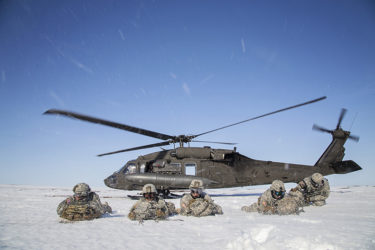
Climate Security: What can the US Army do to prepare for climate change?
The US Army War College released a report on the implications of climate change for the US Army. It outlines the threats climate change poses to national security–extreme weather, migration, limited drinking water supplies, changing vectors of infectious disease, Arctic competition, and sea level rise—and what the Army should do to prepare.
The report assumes that significant changes to the climate have already occurred, and human behavior can mitigate the negative impacts that result from a changing climate.
Climate Change Threatens National Security
Extreme Weather, Sea Level Rise, and Scarcity
Sea level rise, water and food scarcity, and more extreme weather events are likely to force millions to migrate. Human migration can result in the increased propensity for conflict as competition for resources increases. Migration will be most pronounced in areas most vulnerable to climate change, like Southeast Asia, and the problem will be exacerbated by weak institutions and governance.
Salt Water Intrusion
Salt water intrusion will compromise fresh water supplies in many parts of the world. Yet, warmer weather will increase hydration requirements. This means that the Army will need to supply itself with drinkable water, creating a logistical burden for future battlefield deployments.
Infectious Disease
The rise in temperature will increase the range of insects that are vectors of infectious tropical diseases. Coupled with mass human migration, will increase the spread of infectious diseases. In event of a significant infectious disease outbreak, the Army is likely to be called upon to assist in the response.
Melting Arctic Ice
The decrease in Arctic sea ice will bring conflicting claims to newly accessible natural resources. It will also introduce the potential military contact between Russia and other Arctic nations, including the US.
Recommendations
Considering the threats to US national security, the report posits that the Army must consider changes in equipping, training, organization, and policies in order to prepare. Furthermore, the report makes the case that focused research and funding are needed ensure the Army has the tools necessary to battle salt water intrusion, infectious diseases, and other challenges posed by a changing climate.
The authors of the report make clear that the Army must bolster its relationships, and that of DoD’s, with governments in areas where future conflict is more likely to occur and assist in mitigate the impacts of mass migration, as a result of climate change.
One area that does not get enough attention in the report is the threat climate change poses to the Army’s physical infrastructure. Increased flooding, high winds, and extreme rainfall, all have the potential to damage buildings and other infrastructure in and around US Army bases. American Security Project’s Military Base Resilience website identifies how extreme storms, sea level rise, extreme heat and drought, and Arctic ice melt are affecting, and have the potential to effect, military facilities. The website also outlines necessary actions and opportunities for the military to take in order to prepare.
Climate change is not going away; it is a today problem. The US Army must take steps now to mitigate and adapt to the threats posed to national security as a result of a changing climate.
Read the full report report.





